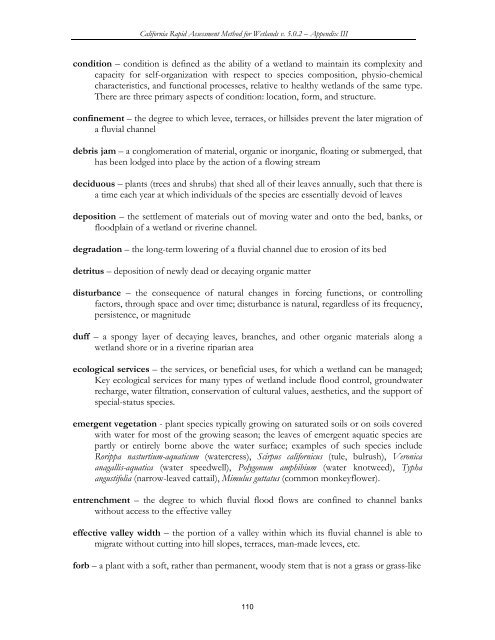California Rapid Assessment Method for Wetlands - State Water ...
California Rapid Assessment Method for Wetlands - State Water ...
California Rapid Assessment Method for Wetlands - State Water ...
Create successful ePaper yourself
Turn your PDF publications into a flip-book with our unique Google optimized e-Paper software.
<strong>Cali<strong>for</strong>nia</strong> <strong>Rapid</strong> <strong>Assessment</strong> <strong>Method</strong> <strong>for</strong> <strong>Wetlands</strong> v. 5.0.2 – Appendix III<br />
condition – condition is defined as the ability of a wetland to maintain its complexity and<br />
capacity <strong>for</strong> self-organization with respect to species composition, physio-chemical<br />
characteristics, and functional processes, relative to healthy wetlands of the same type.<br />
There are three primary aspects of condition: location, <strong>for</strong>m, and structure.<br />
confinement – the degree to which levee, terraces, or hillsides prevent the later migration of<br />
a fluvial channel<br />
debris jam – a conglomeration of material, organic or inorganic, floating or submerged, that<br />
has been lodged into place by the action of a flowing stream<br />
deciduous – plants (trees and shrubs) that shed all of their leaves annually, such that there is<br />
a time each year at which individuals of the species are essentially devoid of leaves<br />
deposition – the settlement of materials out of moving water and onto the bed, banks, or<br />
floodplain of a wetland or riverine channel.<br />
degradation – the long-term lowering of a fluvial channel due to erosion of its bed<br />
detritus – deposition of newly dead or decaying organic matter<br />
disturbance – the consequence of natural changes in <strong>for</strong>cing functions, or controlling<br />
factors, through space and over time; disturbance is natural, regardless of its frequency,<br />
persistence, or magnitude<br />
duff – a spongy layer of decaying leaves, branches, and other organic materials along a<br />
wetland shore or in a riverine riparian area<br />
ecological services – the services, or beneficial uses, <strong>for</strong> which a wetland can be managed;<br />
Key ecological services <strong>for</strong> many types of wetland include flood control, groundwater<br />
recharge, water filtration, conservation of cultural values, aesthetics, and the support of<br />
special-status species.<br />
emergent vegetation - plant species typically growing on saturated soils or on soils covered<br />
with water <strong>for</strong> most of the growing season; the leaves of emergent aquatic species are<br />
partly or entirely borne above the water surface; examples of such species include<br />
Rorippa nasturtium-aquaticum (watercress), Scirpus cali<strong>for</strong>nicus (tule, bulrush), Veronica<br />
anagallis-aquatica (water speedwell), Polygonum amphibium (water knotweed), Typha<br />
angustifolia (narrow-leaved cattail), Mimulus guttatus (common monkeyflower).<br />
entrenchment – the degree to which fluvial flood flows are confined to channel banks<br />
without access to the effective valley<br />
effective valley width – the portion of a valley within which its fluvial channel is able to<br />
migrate without cutting into hill slopes, terraces, man-made levees, etc.<br />
<strong>for</strong>b – a plant with a soft, rather than permanent, woody stem that is not a grass or grass-like<br />
110















